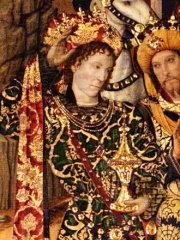
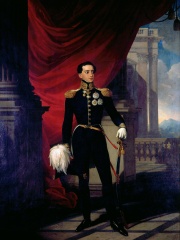
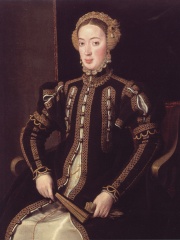
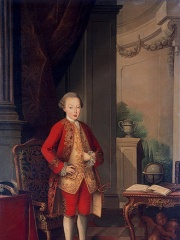
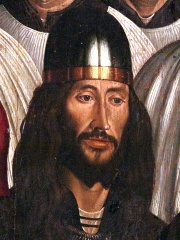
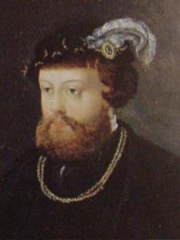
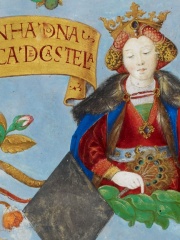
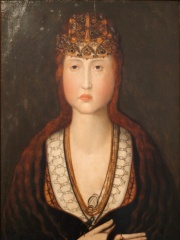
The Most Famous
NOBLEMEN from Portugal
This page contains a list of the greatest Portuguese Noblemen. The pantheon dataset contains 1,415 Noblemen, 13 of which were born in Portugal. This makes Portugal the birth place of the 15th most number of Noblemen behind Luxembourg, and Netherlands.
Top 10
The following people are considered by Pantheon to be the top 10 most legendary Portuguese Noblemen of all time. This list of famous Portuguese Noblemen is sorted by HPI (Historical Popularity Index), a metric that aggregates information on a biography's online popularity. Visit the rankings page to view the entire list of Portuguese Noblemen.

1. Afonso de Albuquerque (1453 - 1515)
With an HPI of 74.86, Afonso de Albuquerque is the most famous Portuguese Nobleman. His biography has been translated into 59 different languages on wikipedia.
Afonso de Albuquerque, 1st Duke of Goa (c. 1453 – 16 December 1515), was a Portuguese general, admiral, statesman and conquistador. He served as viceroy of Portuguese India from 1509 to 1515, during which he expanded Portuguese influence across the Indian Ocean and built a reputation as a fierce and skilled military commander. Albuquerque advanced the three-fold Portuguese grand scheme of combating Islam, spreading Christianity, and securing the trade of spices by establishing a Portuguese Asian empire. Among his achievements, Albuquerque managed to conquer Goa and was the first European of the Renaissance to raid the Persian Gulf, and he led the first voyage by a European fleet into the Red Sea. He is generally considered a highly effective military commander, and "probably the greatest naval commander of the age", given his successful strategy of attempting to close all the Indian Ocean naval passages to the Atlantic, Red Sea, Persian Gulf, and to the Pacific, transforming it into a Portuguese mare clausum. He was appointed head of the "fleet of the Arabian and Persian sea" in 1506. Many of the conflicts in which he was directly involved took place in the Indian Ocean, in the Persian Gulf regions for control of the trade routes, and on the coasts of India. His military brilliance in these initial campaigns enabled Portugal to become the first global empire in history. He led the Portuguese forces in numerous battles, including the conquest of Goa in 1510 and the capture of Malacca in 1511. During the last five years of his life, he turned to administration, where his actions as the second governor of Portuguese India were crucial to the longevity of the Portuguese Empire. He oversaw expeditions that resulted in establishing diplomatic contacts with the Ayutthaya Kingdom through his envoy Duarte Fernandes, with Pegu in Myanmar, and Timor and the Moluccas through a voyage headed by António de Abreu and Francisco Serrão. He laid the path for European trade with Ming China through Rafael Perestrello. He also aided in establishing diplomatic relations with Ethiopia, and established diplomatic ties with Persia during the Safavid dynasty. Throughout his career, he received epithets such as "the Terrible", "the Great", "the Lion of the Seas", "the Portuguese Mars", and "the Caesar of the East".

2. Miguel I of Portugal (1802 - 1866)
With an HPI of 72.62, Miguel I of Portugal is the 2nd most famous Portuguese Nobleman. His biography has been translated into 44 different languages.
Dom Miguel I (26 October 1802 – 14 November 1866), known by several nicknames, was the King of Portugal between 1828 and 1834. He was the son of King John VI and Queen Carlota Joaquina. Following his exile as a result of his actions in support of absolutism in the April Revolt (Abrilada) of 1824, Miguel returned to Portugal in 1828 as regent and fiancé of his niece who was Queen Maria II. As regent, he claimed the Portuguese throne in his own right, since according to the so-called Fundamental Laws of the Kingdom his older brother Pedro IV and therefore the latter's daughter had lost their rights from the moment that Pedro had made war on Portugal and become the sovereign of a foreign state (Brazilian Empire). This led to a difficult political situation, during which many people were killed, imprisoned, persecuted or sent into exile, and which culminated in the Portuguese Liberal Wars between authoritarian absolutists and progressive constitutionalists. In the end, Miguel was forced out from the throne and lived the last 32 years of his life in exile.

3. Maria of Portugal, Duchess of Viseu (1521 - 1577)
With an HPI of 65.84, Maria of Portugal, Duchess of Viseu is the 3rd most famous Portuguese Nobleman. Her biography has been translated into 19 different languages.
Maria, Duchess of Viseu (18 June 1521 – 10 October 1577; Portuguese pronunciation: [mɐˈɾiɐ]) was an infanta of Portugal, the only daughter of King Manuel I of Portugal and his third wife, Eleanor of Austria. A noted patron of the arts and buildings, Maria's personal wealth rivaled that of her half-brother, King John III of Portugal, making her the richest woman in Portugal and one of the wealthiest princesses in Europe.

4. José, Prince of Brazil (1761 - 1788)
With an HPI of 64.72, José, Prince of Brazil is the 4th most famous Portuguese Nobleman. His biography has been translated into 18 different languages.
Dom José, Prince of Brazil, Duke of Braganza (Portuguese pronunciation: [ʒuˈzɛ]; 20 August 1761 – 11 September 1788) was the heir apparent to the Kingdom of Portugal until his death in 1788, as the eldest child of Queen Dona Maria I of Portugal and King Dom Pedro III of Portugal, members of the House of Braganza. José died of smallpox at the age of 27, causing his younger and ill-prepared brother, Infante João, to become heir apparent, Prince Regent to their mentally ill mother and eventually King. João's regency and reign would be a turbulent one, seeing the Napoleonic invasion of Portugal and the loss of the Portuguese Empire's largest and wealthiest colony, Brazil.
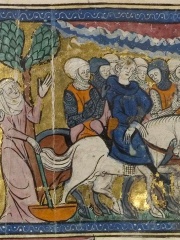
5. Ferdinand, Count of Flanders (1188 - 1233)
With an HPI of 64.11, Ferdinand, Count of Flanders is the 5th most famous Portuguese Nobleman. His biography has been translated into 21 different languages.
Ferdinand (Portuguese: Fernando, French and Dutch: Ferrand; 24 March 1188 – 27 July 1233) reigned as jure uxoris Count of Flanders and Hainaut from his marriage to Countess Joan, celebrated in Paris in 1212, until his death.

6. Ferdinand the Holy Prince (1402 - 1443)
With an HPI of 63.12, Ferdinand the Holy Prince is the 6th most famous Portuguese Nobleman. His biography has been translated into 21 different languages.
Ferdinand the Holy Prince (Portuguese pronunciation: [fɨɾˈnɐ̃du]; Portuguese: Fernando o Infante Santo; 29 September 1402 – 5 June 1443), sometimes called the "Saint Prince" or the "Constant Prince", was an infante of the Kingdom of Portugal. He was the youngest of the "Illustrious Generation" of 15th-century Portuguese princes of the House of Aviz, and served as lay administrator of the Knightly Order of Aviz. In 1437, Ferdinand participated in the disastrous Siege of Tangier led by his older brother Henry the Navigator. In the aftermath, Ferdinand was handed over to the Marinid rulers of Morocco as a hostage for the surrender of Ceuta in accordance with the terms of a treaty negotiated between the rulers of Portugal and Morocco by Henry. At first, Ferdinand was held in relative comfort as a noble hostage in Asilah, but when it became apparent that the Portuguese authorities had no intention of giving up Ceuta, Ferdinand's status was downgraded; he was transferred to a prison in Fez, where he was subjected to much harsher incarceration conditions by his jailers. Negotiations for his release continued intermittently for years, but they came to naught, and Ferdinand eventually died in captivity in Fez on 5 June 1443. A popular cult quickly developed in Portugal around the figure of "the Holy Prince" (O Infante Santo), strongly encouraged by the House of Aviz. Ferdinand remains a "popular saint" by Portuguese tradition, neither beatified nor canonized by the Catholic Church.

7. Duarte, Duke of Guimarães (1515 - 1540)
With an HPI of 63.08, Duarte, Duke of Guimarães is the 7th most famous Portuguese Nobleman. His biography has been translated into 18 different languages.
Duarte, Duke of Guimarães (7 October 1515 – 20 September 1540) was a Portuguese infante (prince); the sixth son of King Manuel I of Portugal and his wife Maria of Aragon.

8. Constance of Portugal (1290 - 1313)
With an HPI of 62.62, Constance of Portugal is the 8th most famous Portuguese Nobleman. Her biography has been translated into 19 different languages.
Constance of Portugal (pt: Constança; 3 January 1290 – Sahagún, 18 November 1313; Portuguese pronunciation: [kõʃˈtɐ̃sɐ]), was Queen of Castile by her marriage to Ferdinand IV. She was the eldest child and only daughter of King Denis of Portugal and his wife Elizabeth of Aragon, later Saint.

9. Joanna, Princess of Portugal (1452 - 1490)
With an HPI of 62.56, Joanna, Princess of Portugal is the 9th most famous Portuguese Nobleman. Her biography has been translated into 17 different languages.
Joanna of Portugal OP (6 February 1452 – 12 May 1490; Portuguese: Joana, Portuguese pronunciation: [ˈsɐ̃tɐ ʒuˈɐnɐ pɾĩˈsezɐ]) was a Portuguese regent princess of the House of Aviz, daughter of King Afonso V of Portugal and his first wife, Queen Isabel of Coimbra. She served as regent during the absence of her father in 1471. In 1475 she became a cloistered nun of the Dominican Order. She is venerated in the Catholic Church with the title 'Blessed', is commemorated by a feast on May 12, and is commonly known in Portugal as Holy Princess Joan (Portuguese: Santa Joana Princesa).

10. Isabel Luísa, Princess of Beira (1669 - 1690)
With an HPI of 62.16, Isabel Luísa, Princess of Beira is the 10th most famous Portuguese Nobleman. Her biography has been translated into 19 different languages.
Infanta Isabel Luísa Josefa of Portugal (6 January 1669 – 21 October 1690) was the only child of Peter II of Portugal and his first wife and former sister-in-law, Maria Francisca of Savoy. She was the heiress presumptive to the throne of Portugal between 1674 and 1689, when her half-brother John was born. As such, she was styled Princess of Beira.
People
Pantheon has 13 people classified as Portuguese noblemen born between 1188 and 1865. Of these 13, none of them are still alive today. The most famous deceased Portuguese noblemen include Afonso de Albuquerque, Miguel I of Portugal, and Maria of Portugal, Duchess of Viseu.
Deceased Portuguese Noblemen
Go to all RankingsAfonso de Albuquerque
1453 - 1515
HPI: 74.86
Miguel I of Portugal
1802 - 1866
HPI: 72.62
Maria of Portugal, Duchess of Viseu
1521 - 1577
HPI: 65.84
José, Prince of Brazil
1761 - 1788
HPI: 64.72
Ferdinand, Count of Flanders
1188 - 1233
HPI: 64.11
Ferdinand the Holy Prince
1402 - 1443
HPI: 63.12
Duarte, Duke of Guimarães
1515 - 1540
HPI: 63.08
Constance of Portugal
1290 - 1313
HPI: 62.62
Joanna, Princess of Portugal
1452 - 1490
HPI: 62.56
Isabel Luísa, Princess of Beira
1669 - 1690
HPI: 62.16
Peter, Constable of Portugal
1429 - 1466
HPI: 61.61
Infanta Ana de Jesus Maria of Braganza
1806 - 1857
HPI: 61.36
Overlapping Lives
Which Noblemen were alive at the same time? This visualization shows the lifespans of the 4 most globally memorable Noblemen since 1700.

